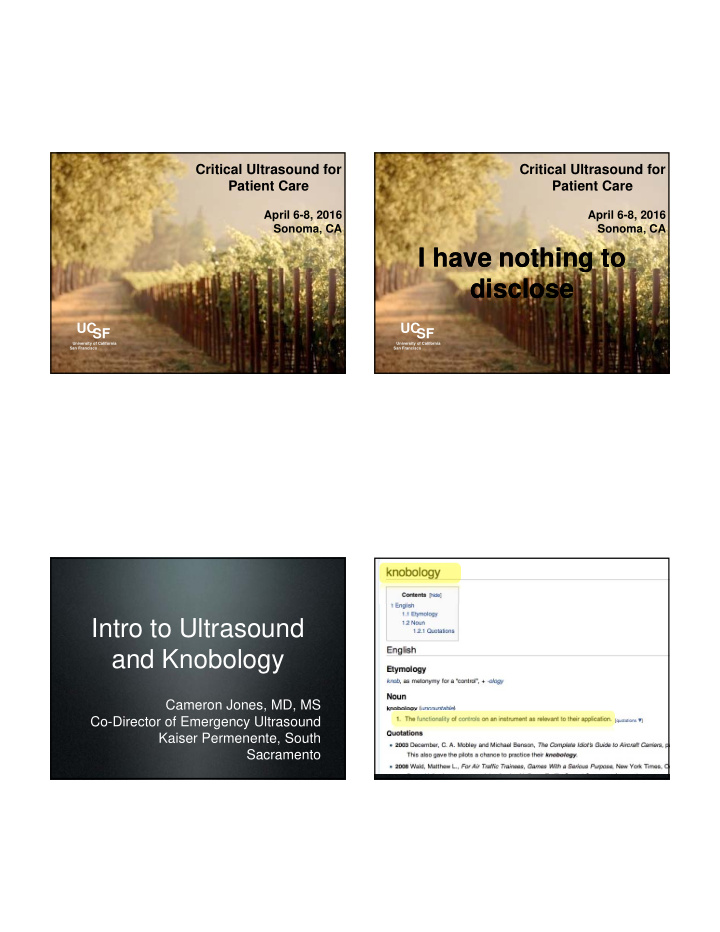



3/29/2016 Critical Ultrasound for Critical Ultrasound for Patient Care Patient Care April 6-8, 2016 April 6-8, 2016 Sonoma, CA Sonoma, CA I have nothing to I have nothing to disclose disclose UC UC SF SF University of California University of California San Francisco San Francisco Intro to Ultrasound and Knobology Cameron Jones, MD, MS Co-Director of Emergency Ultrasound Kaiser Permenente, South Sacramento 1
3/29/2016 SOUND : Series of pressure waves traveling through a medium • Physics Words • WAVELENGT H : Distance traveled in one cycle • FREQUENCY : number of cycles per sec (Hertz) What is “ULTRASOUND” ALARA “As low as reasonably achievable” • No confirmed biological effects on patients or operators have been reported • Intensities typical of diagnostic ultrasound Diagnostic US: 2.5-14 MHz 2
3/29/2016 How it works Cocktail Party Words • PIEZOELECTRIC EFFECT : crystals vibrate at a given frequency when an alternating current is applied Pulsed Wave Output How it works • Echo’s have discrete amplitudes and are thus assigned a specific “brightness” and location on the screen • Screen location of “brightness”/echo depends on time wave took to return and direction it returned from 3
3/29/2016 Ultrasound Modes Motion Mode B-mode Displays returning echo’s along one line of B-mode over Brightness Mode: Different shades of gray time Color Doppler Power Doppler The doppler shift Direction and velocity are color-coded and projected on the B-mode image Does NOT examine flow velocity or direction of flow 4
3/29/2016 Transducers (aka: Probes) Pulsed Wave Doppler Increasing frequency improves resolution at the expense of penetration Displays “spectrum” of returned doppler frequencies Resolution: Ability to delineate Resolution between 2 different objects Axial Resolution: Lateral Resolution: The ability to separate objects linear to the Ability to separate 2 ultrasound beam structures side by side 5
3/29/2016 Transducer basics Transducer basics Convex Array : Phased Array : Sector Scanning - Flat Head, crystals fire at Resolution becomes variable time poorer at greater depths Transducer basics Transducer Indicator “Probe Dot” Linear Array 6
3/29/2016 Learning the language Echogenicity It just takes time... • Hyperechoic • More echogenic than surrounding tissue • Object has lots of echo’s, appears brighter Echogenicity Echogenicity • Hypoechoic • Anechoic / Echolucent • Less echogenic than surrounding • Absence of tissue returning echo’s • Very few echo’s, • Area is black appears darker 7
3/29/2016 Probe Position and Image Image Orientation Orientation • In relation to probe Longitudinal Transverse dot • Transverse • Longitudinal • Coronal / Sagittal Transverse Longitudinal Head Foot Left Right 8
3/29/2016 Button Basics Depth • Shallower • Deeper Coronal (Longitudinal) Button Basics - Depth Button Basics - Depth 9
3/29/2016 Button Basics - Depth Button Basics • Gain • Strength of returning echoes • Amplifier • Gain is adjusted differently depending on the machine Goldilocks and the 3 Bears Goldilocks and the 3 Bears Top overgained, Bottom undergained Bottom overgained, Top undergained 10
3/29/2016 Goldilocks and the 3 Bears Goldilocks and the 3 Bears Entire field overgained Entire field undergained Gain Goldilocks and the 3 Bears “What if I get lost?” AUTO GAIN • “I have messed Make Gain Uniform around with the gain knobs, and now I can’t see anything...” • AUTO GAIN Perfect gain top to bottom 11
3/29/2016 ATTENUATION: Reduction of ATTENUATION: Reduction of intensity and amplitude intensity and amplitude • Absorption : Most common, creates heat • Scattering : non-homogeneous surface • Reflection : “Echo” • Refraction : Different densities Artifacts: Artifacts: Attenuation Artifacts Attenuation Artifacts • Shadowing • Partial or total reflection of sound • Weak or no transmission posterior • Shadowing • High attenuating tissue leaves an acoustic shadow 12
3/29/2016 Artifacts: Artifacts: Attenuation Artifacts Attenuation Artifacts • Posterior • Posterior Enhancement Enhancement • Area behind echo- • Echoes enhanced weak or echo-free posteriorly behind low structure appears attenuating tissue brighter Artifacts: Artifacts: Attenuation Artifacts Attenuation Artifacts • Edge Artifact aka • Posterior “Side Lobe” Enhancement • Sound waves are • Echoes enhanced scattered when they posteriorly behind low encounter cystic wall attenuating tissue or curved surface • Adjust gain to view a • Energy loss clearer image 13
3/29/2016 Artifacts: Artifacts: Attenuation Artifacts Propagation Artifacts • Reverberation • Edge Artifact • Sound encounters 2 highly reflective layers • Sound is bounced back and forth • Probe detects a longer traveling time Artifacts: Artifacts: Propagation Artifacts Propagation Artifacts • Reverberation • Comet Tail • Recurrent bright arcs at equidistant intervals • Narrowly spaced reverb • very strong reflector 14
3/29/2016 Artifacts: Artifacts: Propagation Artifacts Mirror Image • Mirror Imaging • Sound glances off Liver Liver highly reflective surface (diaphragm) • Returning sound waves have longer travel time • Misinterpretation of Mirror Mirror Diaphragm “more liver” Diaphragm Artifacts: Artifacts: Propagation Artifacts Mirror Image • Mirror Imaging Liver Liver Mirror Diaphragm 15
3/29/2016 Artifacts: Artifacts: Mirror Image Propagation Artifacts • Mirror Imaging Liver Liver Liver No Mirror No Mirror Diaphragm Diaphragm Artifacts: Trouble-Shooting Mirror Imaging 16
3/29/2016 Image Acquisition Tips Trouble-Shooting • “I am having a hard time finding _____, do you have any tips?” Know your anatomy • Use more gel! Define boundaries • Transducer movements Choose the proper transducer • F an Learn acoustic windows • A ngle Go from wider view and zoom in Visualize the anatomy in two planes • R otate • T ranslocate / T ry a new location (window) Maximize system controls - depth/gain/frequency Only try one movement at a time Historical Perspective Why Ultrasound? 2010 1832 editorial 1946 • “Like most new technology, there is a risk that new practitioners will make mistakes based on their erroneous interpretations” • “This technology, therefore, MUST BE RESTRICTED” 17
3/29/2016 Why Ultrasound? • 1962 - First B-mode scanner 2012 Questions? Where will we be in 2062? 18
Recommend
More recommend